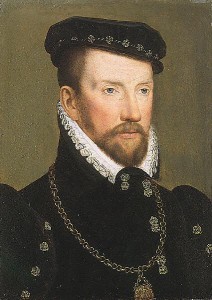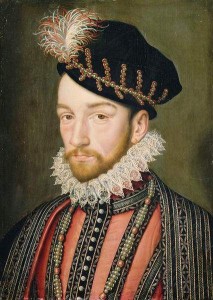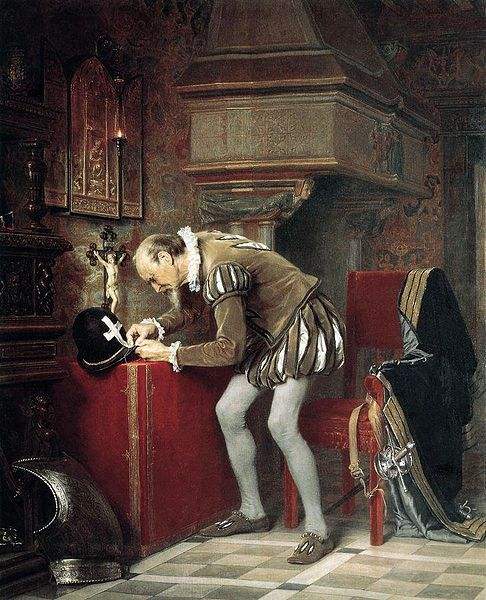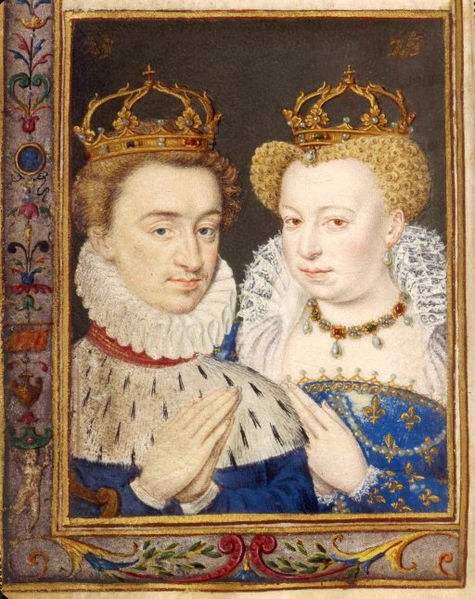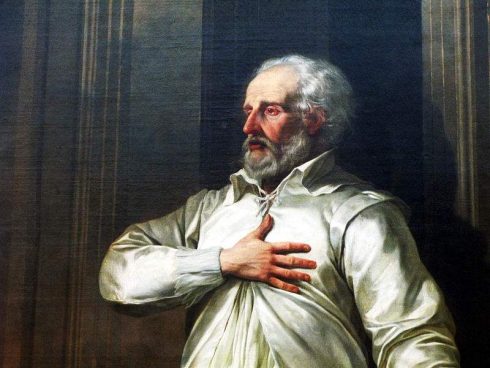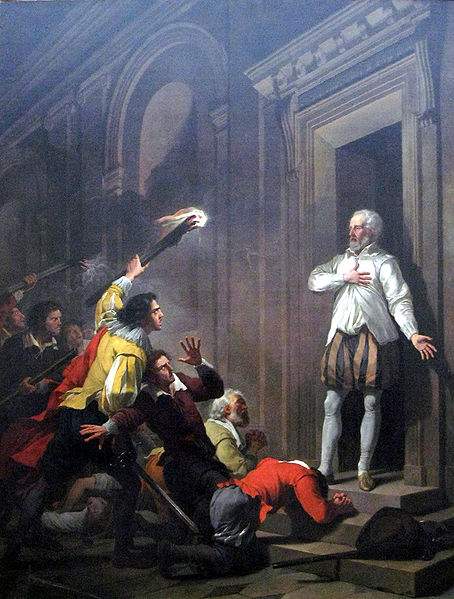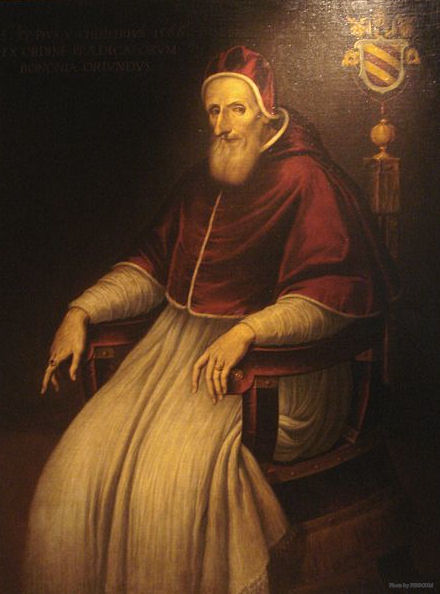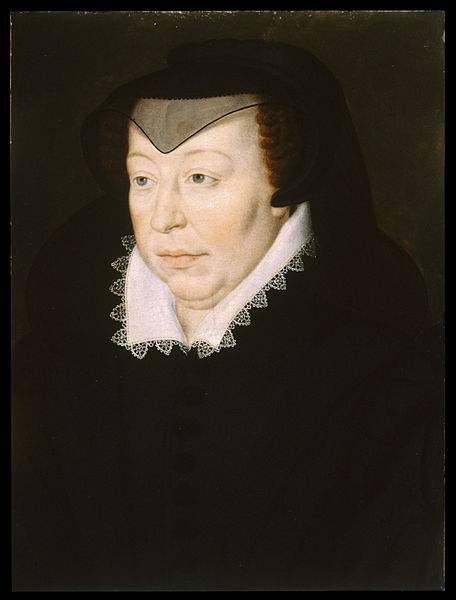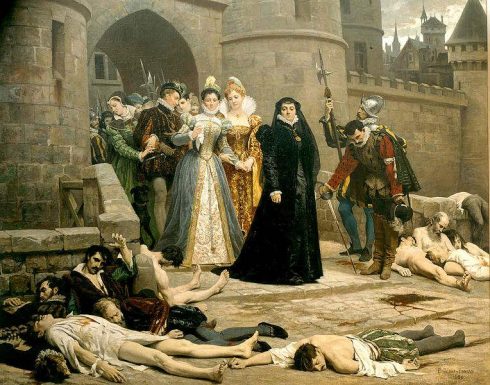Saint Bartholomew’s Day
This massacre of which Protestants were the victims occurred in Paris on 24 August, 1572 (the feast of St. Bartholomew), and in the provinces of France during the ensuing weeks, and it has been the subject of knotty historical disputes.
The first point argued was whether or not the massacre had been premeditated by the French Court – Sismondi, Sir James Mackintosh, and Henri Bordier maintaining that it had, and Ranke, Henri Martin, Henry White, Loiseleur, H. de la Ferrière, and the Abbé Vacandard, that it had not. The second question debated was the extent to which the court of Rome was responsible for this outrage. At present only a few over-zealous Protestant historians claim that the Holy See was the accomplice of the French Court: this view implies their belief in the premeditation of the massacre, which is now denied by the majority of historians. For the satisfactory solution of the question it is necessary to distinguish carefully between the attempted murder of Coligny on 22 August and his assassination on the night of 23-24 August, and the general massacre of Protestants.
The idea of a summary execution of the Protestant leaders, which would be the means of putting an end to the civil discord that had caused three “religious wars” in France in 1562-1563, 1567-1568, and 1569-1570 respectively, had long existed in the mind of Catherine de’ Medici, widow of Henry II and mother of the three successive kings, Francis II, Charles IX, and Henry III; it had also been entertained by her sons. As early as 1560 Michaelis Suriano, the Venetian ambassador, wrote: “Francis II (1559-1560) wanted to fall upon the Protestant leaders, punish them without mercy and thus extinguish the conflagration.” When, in 1565, Catherine de’ Medici with her son Charles IX (1560-1574) and her daughters Margaret of Valois and Elizabeth, wife of Philip II, investigated the political and religious questions of the hour at the conferences of Bayonne, the Duke of Alba, who was present on these occasions, wrote to Philip II: “A way to be rid of the five, or at most six, who are at the head of the faction and direct it, would be to seize their persons and cut off their heads or at least to confine them where it would be impossible for them to renew their criminal plots.” Just at that time Alava on his side confided to the same Spanish king this dark forecast, “I foresee that these heretics will be completely wiped out”.
In 1569 Catholics and Protestants were in arms one against the other, and the Venetian ambassador, Giovanni Carrero, remarked: “It is the common opinion that, in the beginning it would have sufficed to do away with five or six heads and no more”. This same year Parliament promised a reward of 50,000 écus to whoever would apprehend the Admiral de Coligny (1517-72), leader of the Calvinist party, the king adding that this sum would be awarded to him who would deliver up the admiral either alive or dead. Maurevel tried to overtake the admiral for the purpose of killing him but instead only assassinated one of his lieutenants. Thus we see that the idea of a summary execution of the leaders of Protestantism was in the air from 1560 to 1570; moreover it was conformable to the doctrine of political murder as it flourished during the sixteenth century when the principles of social morality and Christian politics elaborated by the theology of the Middle Ages, were replaced by the lay and half-pagan doctrine of Machiavellianism, proclaiming the right of the strongest or the most crafty.
The peace signed at Saint-Germain, August, 1570, between the Court and the Protestants seemed to reestablish order. It was sanctioned by conferences held at La Rochelle in which on the one side a war was planned against Philip II, all the Calvinist nobility being supposed to enlist; and on the other, the marriage of Henry of Bourbon (the future King Henry IV), a Calvinist and the son of Jeanne of Albret, with Margaret of Valois, sister of Charles IX. On 12 September, 1571, the Admiral de Coligny came to Blois, where Charles IX resided, to superintend and further this new policy, and it would seem that just at that time the king was sincere in seeking the support of Coligny and the Protestants against Philip II. And Catherine de’ Medici was shrewdly endeavouring to court favour on all sides. Upon hearing of Spain’s victory at Lepanto (7 October, 1571), she remonstrated with Charles IX for his lack of policy in severing relations with Philip II; and in June, 1572, she tried to arrange a marriage between her third son, the Duke of Alençon, and the Protestant Elizabeth of England, and also made active preparations for the marriage of Margaret of Valois with Henry of Bourbon, taking every means to have it solemnized in Paris.
Meanwhile Coligny, with money which Charles IX had given him unknown to Catherine, sent 4000 men to the relief of Mons, who was at the time besieged by the Duke of Alba. They were beaten (11 July, 1572) and the Duke of Alba, having ascertained that Charles IX was instrumental in the attempt to defeat him, thenceforth entertained the most hostile feeling toward the French King. Charles IX, greatly irritated, made open preparations for war against Spain, relying on Coligny for assistance. Suddenly on 4 August, Catherine made her way to Charles IX, who was then hunting at Montripeau, and insisted that unless he would give up the conflict with Philip II she would withdraw to Florence, taking with her the Duke of Anjou. A conference was held and Coligny, with the idea of sustaining his co-religionists in Flanders, demanded war with Spain, but the council unanimously refused it. Then with rash audacity Coligny declared to the king and to Catherine that if war were not waged against Spain, another war might be expected. From this Catherine deduced that the Protestant party, with the admiral for spokesman, threatened the King of France with a religious war which would be the fourth within ten years.
At the time of the marriage of Henry of Bourbon and Margaret of Valois (18 August), the situation was as follows: on the one side were the Guises with their troops, and on the other Coligny and his musketeers, while Charles IX, although recognizing both parties, leaned more towards Coligny, and Catherine favoured the Guises with a view to revenging herself on Coligny and recovering her influence over Charles IX. Just at this time Philip II was of the opinion that the King of France should strike a decisive blow against the Protestants, and we have proof of this in a letter written to Cardinal Come, Secretary of State to Gregory XIII, by the Archbishop of Rossano, nuncio in Spain. Wrote the nuncio:
The King (Philip II) bids me say that if his Most Christian Majesty means to purge his kingdom of its enemies, the time is now opportune, and that by coming to terms with him (Philip II) His Majesty could destroy those who are left. Now, especially as the Admiral is at Paris where the people are attached to the Catholic religion and to their king, it would be easy for him (Charles IX) to do away with him (Coligny) forever.
It is probable that Philip II sent similar suggestions to his ministers at Paris, and that the latter conferred with Catherine and the Duke of Anjou, even offering them military assistance for the struggle against the Protestants. This intervention caused Catherine to plan Coligny’s assassination, and at a meeting to which she called Madame de Nemours, widow of the great Duke of Guise, it was decided that Maurevel should set a trap for the admiral. This was done, with the result that on the morning of 22 August, a musket-shot fired by Maurevel struck Coligny although wounding him but slightly. The Protestants became excited and Charles IX grew angry, declaring that the peace edict must be observed. He went to visit the wounded Coligny and Catherine accompanied him, but at Coligny’s request she had to withdraw and, if we may credit the account given by the Duke of Anjou (Henry III), the admiral, lowering his voice, warned Charles IX against his mother’s influence. But just at that moment Charles had but one idea, which was to find and punish Henry of Guise, whom he suspected of being the instigator if not the perpetrator of the attempt on Coligny’s life.
It was because the attack made on Coligny, 22 August, had failed that Catherine conceived the idea of a general massacre. “If the Admiral had died from the shot,” wrote Salviati, the nuncio, “no others would have been killed.” Those historians who claim the massacre to have been premeditated explain that Catherine had the marriage of Margaret and Henry of Bourbon solemnized in Paris in order to bring the Protestant leaders there for the purpose of murdering them. However, this interpretation is based merely upon a very doubtful remark attributed to Cardinal Alessandrino and of which we shall speak later on, and it was certainly unlike Catherine, who was always more inclined to placate the various parties by dint of subtle manoeuvring them, after careful deliberation, to inaugurate a series of irreparable outrages. As we shall see, the decision to have recourse to a massacre arose in Catherine’s mind under pressure of a sort of madness; she saw in this decision a means of preserving her influence over the king and of preventing the vengeance of Protestants, who were exasperated by the attack made on Coligny. “The Admiral’s death was premeditated, that of the others was sudden,” wrote Don Diego de Zuniga to Philip II, on 6 September 1572. Herein lies the exact difference: the attempt on Coligny’s life was premeditated whereas the massacre was the outcome of a cruel impulse. On the night of 22 August Catherine de’ Medici felt herself lessened in her son’s consideration. She learned from one Bouchavannes that the Huguenots had decided to meet at Meaux, 5 September, and avenge Coligny’s attempted murder by marching on Paris; she knew that the Catholics were preparing to defend themselves, and she foresaw that between both parties the king would be alone and powerless. At supper she heard Pardaillan, a Huguenot, say that justice would be rendered even if the king would not render it, and Captain Piles, another Huguenot, was of the opinion that “even if the Admiral lost an arm there would be numberless others who would take so many lives that the rivers of the kingdom would run with blood”. The threats of the Huguenots and her son’s consternation impelled Catherine to try to avert this civil war by organizing an immediate massacre of the Protestants.
But Charles IX had to be won over. In the account of the dreadful events subsequently given by the Duke of Anjou he alludes to a single conversation between Catherine and Charles IX on 23 August, but Tavannes and Margaret of Valois mention two, the second of which took place late at night. As to the decisive interview there is conflicting testimony. The Duke of Anjou claims that Charles IX, suddenly converted to the cause by Catherine’s ardent importuning, cried out: “Good God! since you deem it well to kill the Admiral, I agree, but all the Huguenots in France must likewise perish, so that not one be left later to upbraid me.” Cavalli, the Venetian Ambassador, maintained in his report that the king held out for an hour and a half, finally yielding because of Catherine’s threat to leave France and the fear that his brother, the Duke of Anjou, might be named captain-general of the Catholics. Margaret of Valois stated in her account that it was Rets, his former tutor, whom Catherine sent to reason with him, who eventually succeeded in obtaining the king’s consent. Is it then true, as certain documents claim, that, toward midnight, Charles IX again hesitated? Perhaps. At any rate, it was he who, on 24 August, a little after midnight, ordered Le Charron, Prévot des Marchands, in charge of the Paris police, to call to arms the captains and bourgeois of the quarters in order that he (the king) and the city might be protected against the Huguenot conspirators. Catherine and the Duke of Anjou had previously secured the assistance of Marcel, former Prévot des Marchands. Whilst Le Charron, without any great enthusiasm, marshalled the bourgeoisie who were to quell a possible uprising of Huguenots, Marcel drew up the masses, over whom he had unlimited influence, and who, together with the royal troops, were to attack and plunder the Huguenots. The royal troops were especially commissioned to kill the Huguenot nobles; the mob, mobilized by Marcel, was to threaten the bourgeois troops in case the latter should venture to side with the Huguenots. Charles IX and Catherine decided that the massacre should not begin in the city till the admiral had been slain, and afterwards Catherine claimed that she took upon her conscience the blood of only six of the dead, Coligny and five others; however, having deliberately fired the passions of the multitude, over whom Marcel had absolute control, she should be held responsible for all the blood shed.
THE MASSACRE
Toward midnight the troops took up arms in and around the Louvre, and Coligny’s abode was surrounded. A little before daybreak the sound of a pistol-shot so terrified Charles IX and his mother that, in a moment of remorse, they despatched a nobleman to Guise to bid him refrain from any attack on the admiral, but the order came too late; Coligny had already been slain. Scarcely had the Duke of Guise heard the bell of Saint-Germain l’auxerrois than he started with a few men toward the Coligny mansion. Besme, one of the duke’s intimates, went up to the admiral’s room. “Are you Coligny?” he asked. “I am,” the admiral replied. “Young man, you should respect my years. However, do as you please; you will not be shortening my life to any great extent. Besme plunged a dagger into the admiral’s breast and flung his body out the window. The Bastard of Angoulême and the Duke of Guise, who were without, kicked the corpse and an Italian, a servant of the Duke of Nevers, cut off its head. Immediately the king’s guards and the nobles on the side of the Guises slew all the Protestant nobles whom Charles IX, but a few days previously, when he wanted to protect the admiral against the intrigues of the Guises, had carefully lodged in the admiral’s neighbourhood. La Rochefoucauld, with whom that very night Charles IX had jested till eleven o’clock, was stabbed by a masked valet; Téligny, Coligny’s son-in-law, was killed on a roof by a musket-shot, and the Seigneur de la Force and one of his sons had their throats cut, the other son, a child of twelve, remaining hidden beneath their corpses for a day. The servants of Henry of Bourbon and the Prince of Condé who dwelt in the Louvre were murdered under the vestibule by Swiss mercenaries. One nobleman fled to the apartment of Margaret, who had just married Henry of Bourbon, and she obtained his pardon. Whilst their servants were being slaughtered Henry of Bourbon and the Prince of Condé were ordered to appear before the king, who tried to make them abjure, but they refused.
After that the massacre spread through Paris, and Crucé, a goldsmith, Koerver, a bookseller, and Pezou, a butcher, battered in the doors of the Huguenot houses. A tradition, long credited, claims that Charles IX stationed himself on a balcony of the Louvre and fired upon his subjects; Brantôme, however, supposed that the king took aim from the windows of his sleeping apartment. But nothing is more uncertain as the balcony on which he was said to have stood was not there in 1572, and in none of the accounts of the Massacre of Saint Bartholomew sent to their governments by the various diplomatists then in Paris does this detail figure. It was first mentioned in a book published at Basel in 1573: “Dialogue auquel sont traitées plusieurs choses advenues aux Luthériens et Huguenots de France” and reprinted in 1574 under the title: “Le reveille matin des Français”. This libel is the work of Barnaud, a native of Dauphiné, a Protestant greatly disliked by his co-religionists, and whose calumnies caused a Protestant nobleman to insult him in public. The “Tocsin contre les auteurs du Massacre de France”, another narration of the Massacre of St. Bartholomew, that appeared in 1579, makes no allusion to this sinister pastime of Charles IX, and the accounts given of it twenty years afterwards by Brantôme and d’Aubigné do not agree. Moreover, the anecdote quoted by Voltaire, according to which the Maréchal de Tessé had known a gentleman then over a hundred years old who was supposed to have loaded Charles IX’s musket, is extremely doubtful, and the absolute silence of those diplomatists who addressed to their respective governments detailed reports of the massacre must ever remain a strong argument against this tradition.
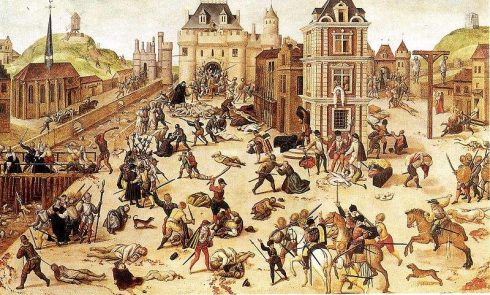
Painting by François Dubois, a Huguenot painter born circa 1529 in Amiens, who settled in Switzerland. Although Dubois did not witness the massacre, he depicts Admiral Coligny’s body hanging out of a window at the rear to the right. To the left rear, Catherine de’ Medici is shown emerging from the Château du Louvre to inspect a heap of bodies.
On the following morning blood flowed in streams; the houses of the rich were pillaged regardless of the religious opinions of their owners. “To be a Huguenot,” emphatically declares Mézeray, the historian, “was to have money, enviable position, or avaricious heirs.” When at eleven o’clock in the morning the Prévot Le Charron came to inform the king of this epidemic of crime, an edict was issued forbidding a continuation of the slaughter; but the massacre was prolonged for several days more, and on 25 August Ramus, the celebrated philosopher, was assassinated in spite of the formal prohibition of the king and queen. The number of victims is unknown. Thirty-five livres were paid to the grave-diggers of the Cemetery of the Innocents for the interment of 1100 corpses; but many were thrown into the Seine. Ranke and Henri Martin estimate the number of victims in Paris at 2000. In the provinces also massacres occurred. On the evening of 24 August, a messenger brought to the Provost of Orléans a letter bearing the royal seal and ordering him to treat all Huguenots like those of Paris and to exterminate them, “taking care to let nothing leak out and by shrewd dissimulation to surprise them all”. Only that day the king had written to M. d’Eguilly, Governor of Chartres, that there was question merely of a quarrel between Guise and Coligny. On 25 August an order was issued to kill the factious; on the next day the king solemnly announced in open session that his decision of 24 August was the only means of frustrating the plot; on 27 August he again began to prohibit all murder; and on the following day he solemnly declared that the punishment of the admiral and his accomplices was due not to their religion but to their conspiracy against the Court, and he despatched letters bidding the governors to repress the factionists; on 30 August he ordered the people of Bourges to kill any Huguenots who should congregate, but revoked “all verbal commands that he had issued when he had just cause to fear some sinister event”. In this series of contradictory instructions may be detected the ever-slumbering antagonism between Catherine’s fixedness of purpose and the vacillation of Charles IX, but almost everywhere in the country the policy of bloodshed prevailed.
The general opinion throughout France was that the king had to kill Coligny and the turbulent in self-defence. President de Thou publicly praised Charles IX; Attorney-General du Faur de Pibrac wrote an apology for the massacre; Jodelle, Baïf, and Daurat, poets of the “Pléiade”, insulted the admiral in their verse; a suit was entered in the Parlement against Coligny and his accomplices whether living or dead, and its immediate result was the hanging of Briquemaut and Cavaignes, two Protestants who had escaped the massacre. This protracted severity on the part of the Parlement of Paris set the pace for outside places, and in many places an excess of zeal led to an increase of brutality. Lyons, Toulouse, Bordeaux, and Rouen all had their massacres. So many Lyonese corpses drifted down the Rhône to Arles that, for three months, the Arlesians did not want to drink the river water. At Bayonne and at Nantes compliance with royal orders was refused. The intervals between these massacres prove that on the first day the Court did not issue formal orders in all directions; for instance, the Toulouse massacre did not occur till 23 September and that of Bordeaux till 3 October. The number of victims in the provinces is unknown, the figures varying between 2000 and 100,000. The “Martyrologe des Huguenots”, published in 1581, brings it up to 15,138, but mentions only 786 dead. At any rate only a short time afterwards the reformers were preparing for a fourth civil war.
From the foregoing considerations it follows:
- That the royal decision of which the St. Bartholomew massacre was the outcome, was in nowise the result of religious disturbances and, strictly, did not even have religious incentives; the massacre was rather an entirely political act committed in the name of the immoral principles of Machiavellianism against a faction that annoyed the Court.
- That the massacre itself was not premeditated; that, up to 22 August, Catherine de’ Medici had only considered – and that for a long time – the possibility of getting rid of Coligny; that the criminal attack made on Coligny was interpreted by the Protestants as a declaration of war, and that, in the face of impending danger, Catherine forced the irresolute Charles IX to consent to the horrible massacre.
Such, then, are the conclusions to be kept in view when entering upon the discussion of that other question, the responsibility of the Holy See.
THE HOLY SEE AND THE MASSACRE
A. Pius V (1566-May 1, 1572)
Pius V, being constantly informed in regard to the civil wars in France and the massacres and depredations there committed, looked upon the Huguenots as a party of rebels who weakened and divided the French Kingdom just when Christianity required the strength of unity in order to strike an effective blow against the Turks. In 1569 he had sent Charles IX 6000 men under the command of Sforza, Count of Santa-Fiore, to help the royal troops in the third religious war; he had rejoiced over the victory at Jarnac (12 March, 1569), and on 28 March had written to Catherine de’ Medici: “If Your Majesty continues openly and freely to fight (aperte ac libere) the enemies of the Catholic Church unto their utter destruction, divine help will never fail you.” After the Battle of Moncontour in October, 1569, he had begged the king thenceforth to tolerate in his states the exercise of Catholicism only; “otherwise,” he said, “your kingdom will be the bloody scene of continual sedition”. The peace concluded in 1570 between Charles IX and the Huguenots caused him grave anxiety. He had endeavoured to dissuade the king from signing it and had written as follows to the Cardinals of Bourbon and Lorraine: “The King will have more to fear from the hidden traps and knavishness of the heretics than from their barefaced brigandage during the war.” What Pius V wanted was an honest, open war waged by Charles IX and the Guises against the Huguenots. On 10 May, 1567, he said to the Spanish Ambassador, Don Juan de Luniga: “The masters of France are meditating something which I can neither advise nor approve and which conscience upbraids: they want to destroy by underhand means the Prince of Condé and the Admiral.” To reestablish political peace and religious unity by the royal sword was the inexorable dream of Pius V who must not be judged according to our modern standards of toleration; but this end, worthy as he deemed it, could not justify the proposed means of attainment; he would sanction no intriguing, and five years previous to the Massacre of St. Bartholomew’s Day, he disapproved the dishonest “means” by which Catherine dreamed of getting rid of Coligny.
B. Cardinal Alessandrino, sent from the Holy See to Paris, in 1572
Some historians have wondered whether Cardinal Alessandrino, sent by Pius V to Charles IX in February, 1572, to persuade the king to join a Catholic league against the Turks, was not an accomplice in Catherine’s murderous designs. In February Alessandrino, who had vainly endeavoured to prevent the marriage of Margaret of Valois with the Protestant Henry of Bourbon, closed his report with these words: “I am leaving France without accomplishing anything whatever: I might as well not have come.” Let us be mindful of this tone of discouragement, this acknowledgment of failure. In March he wrote: “I have other special matters to report to His Holiness but I shall communicate them orally . . . .” When the cardinal returned to Rome Pius V was dying, and he expired without learning what were the “special matters” to which Alessandrino had alluded. Whatever they may have been they certainly have no bearing upon the conclusion that Pius V had been previously informed of the massacre. A life of this pontiff, published in 1587 by Girolamo Catena, gives a conversation that took place a long time afterwards between Alessandrino and Clement VIII in which the cardinal spoke of his former ambassadorship. When he was endeavouring to dissuade the king from Margaret’s marriage to Henry, the king said: “I have no other means of revenging myself on my enemies and the enemies of God.” This fragment of the interview has furnished those who hold that the massacre was premeditated with a reason for maintaining that the solemnizing of the nuptials in Paris was a snare prearranged with the concurrence of the papal nuncio. The most reliable critics contest the perfect authenticity of this interview, chiefly because of the very tardy account of it and of its utter incompatibility with the discouragement manifested in Alessandrino’s notes written the day after the conversation had taken place. The arguments against the thesis of premeditation as we have considered them one by one seem to us sufficiently plausible to permit us to exclude all hypothesis according to which, six months ahead of time, Alessandrino was confidentially apprised of the outrage.
C. Salviati, Nuncio at Paris in 1572
At the time of the Massacre of St. Bartholomew, Salviati, a relative of Catherine de’ Medici, was the pope’s nuncio at Paris. In December, 1571, Pius V had entrusted him with a first extraordinary mission, and at the time Catherine, according to what was subsequently related by the Venetian Ambassador, Michaeli, “had secretly bade him tell Pius V that he would soon see the vengeance that she and the king would visit upon those of the religion (of the Huguenots)”. Catherine’s conversation was so vague that the following summer, when Salviati came back to France as nuncio, she thought he must have forgotten her words. Accordingly she reminded him of the revenge that she had predicted, and neither in December, 1571, nor in August, 1572, was Salviati very explicit in his correspondence with the Court of Rome as, on 8 September, 1572, three weeks after the massacre, Cardinal Come, Secretary of State to Gregory XIII, wrote to Salviati: “Your letters show that you were aware of the preparations for the blow against the Huguenots long before it was dealt. You would have done well to inform His Holiness in time.” In fact on 5 August, Salviati had written to Rome: “The Queen will rap the Admiral’s knuckles if he goes too far” (donnera à l’Admiral sur les ongles), and on 11 August: “Finally, I hope that God will give me the grace soon to announce to you something that will fill His Holiness with joy and satisfaction.” This was all. A subsequent letter from Salviati revealed that this covert allusion was to the scheme of vengeance that Catherine was then projecting in regard to Coligny’s assassination and that of a few Protestant leaders: however, it seems that at the Court of Rome the reference was supposed to be to a re-establishment of cordial relations between France and Spain. The replies of the Cardinal of Come to Salviati show that this last idea was what absorbed the attention of Gregory XIII and that the Court of Rome gave but little heed to Catherine’s threats against the Protestants. Notwithstanding that Salviati was Catherine’s relative and that he was maintaining a close watch, all documents prove, as Soldan, the German Protestant historian, says, that the events of 24 August were accomplished independently of Roman influence. Indeed, so little did Salviati foresee the Massacre of St. Bartholomew itself that he wrote to Rome the day after the event: “I cannot believe that so many would have perished if the Admiral had died of the musket-shot fired at him . . . . I cannot believe a tenth of what I now see before my very eyes.”
D. The attitude of Gregory XIII on receiving the news of the Massacre of St. Bartholomew
It was on 2 September that the first rumours of what had occurred in France reached Rome. Danes, secretary to Mandelot, Governor of Lyons, bade M. de Jou, Commander at Saint-Antoine, to inform the pope that the chief Protestant leaders had been killed in Paris, and that the king had ordered the governors of the provinces to seize all Huguenots. Cardinal de Lorraine, when thus informed, gave the courier 200 écus and Gregory XIII gave him 1000. The pope wanted bonfires lighted in Rome, but Férals, the French Ambassador, objected on the ground that official communication should first be received from the king and the nuncio. On 5 September Beauvillier reached Rome, having been sent thither by Charles IX. He gave an account of the Massacre of St. Bartholomew and begged Gregory XIII to grant, antedating it, the dispensation required for the legitimacy of the marriage of Margaret of Valois and Henry of Navarre, solemnized three weeks previously. Gregory XIII deferred discussing the subject of the dispensation and a letter from the Cardinal de Bourbon dated 26 August and a despatch from Salviati, both received at this time, duly informed him of what had taken place in France. Wrote the Cardinal de Bourbon,
Said Admiral was so wicked as to have conspired to kill said King, his mother, the Queen and his brothers . . . . He (the Admiral) and all the ringleaders of his sect were slain . . . . And what I most commend is the resolution taken by His Majesty to exterminate this vermin.
In his letter describing the massacre Salviati said: “I rejoice that it has pleased the Divine Majesty to take under His protection the King and the Queen-mother.” Thus all the information received from France gave Gregory XIII the impression that Charles IX and his family had been saved from great danger. The very morning of the day that Beauvillier had brought him Salviati’s letter, the pope held a consistory and announced that “God had been pleased to be merciful”. Then with all the cardinals he repaired to the Church of St. Mark for the Te Deum, and prayed and ordered prayers that the Most Christian King might rid and purge his entire kingdom of the Huguenot plague. He believed that the Valois had just escaped a most terrible conspiracy which, had it succeeded, would have unfitted France for the struggle of Christian against Turk. On 8 September a procession of thanksgiving took place in Rome, and the pope, in a prayer after mass, thanked God for having “granted the Catholic people a glorious triumph over a perfidious race” (gloriosam de perfidis gentibus populo catholico loetitiam tribuisti).
A suddenly discovered plot, an exemplary chastisement administered to insure the safety of the royal family, such was the light in which Gregory XIII viewed the St. Bartholomew massacre, and such was likewise the idea entertained by the Spanish Ambassador who was there with him and who, on 8 September, wrote as follows: “I am certain that if the musket-shot fired at the Admiral was a matter of several days’ premeditation and was authorized by the King, what followed was inspired by circumstances.” These circumstances were the threats of the Huguenots, “the insolent taunts of the whole Huguenot party”, alluded to by Salviati in his despatch of 2 September; to put it briefly, these circumstances constituted the conspiracy. However, the Cardinal of Lorraine, who belonged to the House of Guise and resided in Rome, wished to insinuate that the massacre had been planned long ahead by his family, and had a solemn inscription placed over the entrance to the Church of St. Louis des Français, proclaiming that the success achieved was an answer “to the prayers, supplications, sighs and meditation of twelve years”; this hypothesis, according to which the massacre was the result of prolonged hypocrisy, the outcome of a protracted ruse, was shortly afterwards maintained with great audacity in a book by Capilupi, Catherine’s Italian panegyrist. But the Spanish Ambassador refuted this interpretation: “The French,” wrote he, “would have it understood that their King meditated this stroke from the time that he concluded the peace with the Huguenots, and they attribute to him trickery that does not seem permissible even against heretics and rebels.” And the ambassador was indignant at the Cardinal of Lorraine’s folly in giving the Guises credit for having set a trap. The pope did not believe any more than did the Spanish Ambassador in a snare laid by Catholics, but was rather convinced that the conspiracy had been hatched by Protestants.
Just as the Turks had succumbed at Lepanto, the Protestants had succumbed in France. Gregory XIII ordered a jubilee in celebration of both events and engaged Vasari to paint side by side in one of the Vatican apartments scenes commemorative of the victory of Lepanto and of the triumph of the Most Christian King over the Huguenots. Finally, he had a medal struck representing an exterminating angel smiting the Huguenots with his sword, the inscription reading: Hugonottorum strages. There had been a slaughter of conspirators (strages) and the information that reached the pope was identical with that spread throughout Europe by Charles IX. On 21 September Charles IX wrote to Elizabeth of England concerning the “imminent danger” from the plot that he had baffled; on the next day he wrote as follows to La Mothe-Fénélon, his ambassador at London: “Coligny and his followers were all ready to visit upon us the same fate that we dealt out to them”; and to the German princes he sent similar information. Certainly all this seemed justified by the decree of the French magistracy ordering the admiral to be burned in effigy and prayers and processions of thanksgiving on each recurring 24 August, out of gratitude to God for the timely discovery of the conspiracy. It is not surprising, therefore, that, on 22 September, Gregory XIII should have written to Charles IX: “Sire, I thank God that He was pleased to preserve and defend Your Majesty, Her Majesty, the Queen-mother and Your Majesty’s royal bothers from the horrible conspiracy. I do not think that in all history there is mention of such cruel malevolence.” Nor again is it astonishing that the pope should have despatched Cardinal Orsini to Charles IX with congratulations on his escape. From Rome again Cardinal de Pellevé wrote to Catherine de’ Medici: “Madame, the joy of all honest people in this city is complete, and never was there more glad-some news than that of Your Majesty being free from danger.” The discourse delivered 3 December by Muret, the Humanist, was a veritable hymn of thanksgiving for the discovery of the plot contrived against the king and almost all the royal family.
The Huguenot party having plotted regicide had to be punished, and its punishment seemed once more to put France in condition to combat the Turks; such was the twofold aspect under which Rome considered the massacre. Besides, the pope’s joy did not last long. A rather involved account by Brantôme leads us to think that, becoming better informed, he grew angry at the news of such barbarity, and it is certain that when, in October, 1572, the Cardinal of Lorraine wished to present Maurevel, who had fired on Coligny on 22 August, Gregory XIII refused to receive him, saying: “He is an assassin.” Doubtless by this time the vague despatches sent by Salviati during the weeks preceding the massacre had, in the light of events, become more comprehensible and rendered it clearer that the origin of these tragic events was the assault of 22 August; without ceasing to rejoice that Charles IX had eventually escaped the conspiracy then commonly asserted in France and abroad, Gregory XIII judged the criminal, Maurevel, according to his deserts. The condemnation by Pius V of the “intrigues” against Coligny and the refusal of Gregory XIII to receive Maurevel “the assassin” establish the unbending rectitude of the papacy, which, eager as it was for the re-establishment of religious unity, never admitted the pagan theories of a certain raison d’état according to which the end justified the means. As to the congratulations and the manifestations of joy which the news of the massacre elicited from Gregory XIII, they can only be fairly judged by assuming that the Holy See, like all Europe and indeed many Frenchmen, believed in the existence of a Huguenot conspiracy of whose overthrow the Court boasted and whose punishment an obsequious parliament had completed.
Earlier authorities: Mémoires de Marguerite de Valois (coll. Petitot, XXXVII); Discours du Roi Henri III (coll. Petitot, XLIV); Mémoires de Tavanne (coll. du Panthéon littéraire); Correspondance de la Mothe-Fénelon, VII (Paris, 1840); ed. LA FERRIÈRE, Lettres de Catherine de Médicis, IV (Paris, 1891); Négociations diplomatiques de la France avec la Toscane, III; THEINER, Annales ecclesiastici, I (Rome, 1856); MARTIN, Relations des ambassadeurs vénétiens Giovanni Michieli et Sigismond Cavalli (Paris, 1872); Archives curieuses de l’histoire de France (series I, VII, 1835).
Modern works: SOLDAN, La France et la St. Barthélemy, tr. SCHMIDT (Paris, 1855); WHITE, The Massacre of Saint Bartholomew, preceded by a History of the Religious Wars in the Reign of Charles IX (London, 1868); BORDIER, La St. Barthélemy et la critique moderne (Geneva, 1871); LOISELEUR, Trois énigmes historiques (Paris, 1883); LA FERRIÈRE, La Saint Barthélemy, la veille, le jour, le lendemain (Paris, 1892); VACANDARD, Etudes de critique et d’histoire religieuse (3rd ed., Paris, 1906).
GEORGES GOYAU (Catholic Encyclopedia)
